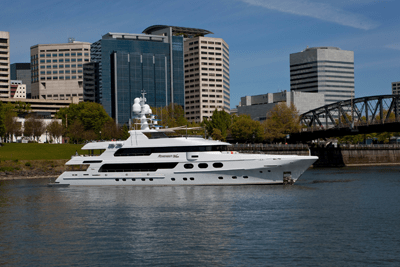With 135 new hires in the last 18 months, and plans to bring another 60 people on board by the end of the year, there’s no doubt that Christensen Shipyards Ltd. is one of the bright spots in Clark County’s economic landscape. Innovation and a commitment to lean manufacturing principles are driving that growth, according to Brad Given, Christensen’s director of continuous improvement.
Founded in 1983, the yacht maker ‘s facilities are situated on seven acres off Columbia Way in Vancouver, with 180,000 square feet of climate-controlled manufacturing space. In 2009, the company spun off Renewable Energy Composite Solutions (RECS), and as part of that process, worked with the Columbia River Economic Development Council (CREDC) and Impact Washington (see sidebar) to implement lean manufacturing processes at RECS.
“The lean ideas began to filter over to the yacht side, with great results,” said Given.
Christensen’s transition to lean was, in part, made possible by funding that the CREDC helped them obtain through state grants and the Southwest Washington Workforce Development Council.
“The CREDC was instrumental in helping us get the training we needed,” said Given.
Riding the lean tide
Although the demand for new yachts has begun to pick up – Christensen has seven projects currently under contract, ranging from 120 to 160 feet in length – the company is using lean manufacturing to decrease the cost of production without affecting the high quality the company is known for, as well to decrease the time it takes to build a new ship.
Given said the company worked with Impact Washington to develop a transformation plan that would transition the company’s processes from the conventional “top-down” manufacturing model to the lean model.
“Lean is very different from the conventional model,” said Given, “especially on the culture side.”
With lean manufacturing, explained Given, a company develops top-down strategies, but implements bottom-up problem solving.
“Who would know better how to improve a process than the person doing it?” he asked.
Given said the goal is to “create a company of problem solvers” instead of having just a few experts. The company’s cafeteria features an entire wall that presents lean manufacturing concepts and successes, and Christensen has recently launched a new continuous improvement program, with a goal of having one “kaizen” (improvement idea) per employee, per month.
“Christensen has taken the lean approach very seriously,” said Kristin Kautz, Impact Washington’s Southwest Washington representative. “They are a textbook case of understanding that it’s not a few events – you need to drive it into the culture.”
Lean processes, robust goals
Given said that Christensen has set aggressive goals for their lean manufacturing program: a 20-percent reduction in contract-to-delivery time and a 25-percent improvement in productivity. He said they had already reduced how long it takes to build a ship from 36 to about 28-30 months, with a mid-term goal of 24 months and an eventual goal of 12 months.
It takes innovation to achieve these goals. For example, said Given, when building a boat, most tools are powered by air and electricity. Historically, a boat in progress was a “spaghetti” of air and power lines, which presented tripping hazards, were constantly getting tangled or disconnected, and took hours to set up and dismantle.
Searching for an improvement idea (AKA the “kaizen”) that could fix this situation, Christensen integrated air and power into the ship’s hull, so that employees can simply plug a tool into a port wherever they are working. Given estimated that the new integrated air and power system saves 1,800 hours per boat of wasted time.
Besides continuous improvement and innovation, Given said another important component of Christensen’s transition to the lean manufacturing model has been “training in industry” – an organized, proven method of job instruction. With the rapid rate of hiring Christensen has been experiencing lately ¬– as many as 10 new employees per month – Given said bringing new employees up to speed in as little time as possible is critical.
Lisa Nisenfeld, president of the CREDC, reported that Christensen president Joe Foggia stated at a recent lean manufacturing panel that the lean training his company received through Impact Washington was so valuable that every bank should require it before they grant a loan.
Raising all boats
Christensen believes their growth isn’t just good for Christensen. According to marketing department spokesperson Megan Farian, Christensen is the “only company in Clark County that gets an order for a $25 million product and 90 percent of that revenue stays in the local economy by way of wages and working with local suppliers.”
“This is a really exciting story for Clark County,” said Kautz. “A company is able to grow again and add jobs.”
Sidebar: Columbia River Economic Development Council & Impact Washington
The Columbia River Economic Development Council, according to organization president Lisa Nisenfeld, exists to “help companies expand by connecting with local resources.” One of those resources for manufacturers is Impact Washington – a state-funded not-for-profit organization established in the early 90s to help keep American manufacturers globally competitive and in business. Impact Washington is part of the Manufacturing Extension Partnership (MEP) program, which is similar to federal agricultural extension offices. There is an MEP affiliate in every state. (See www.nist.gov/mep)
According to Kristin Kautz, Impact Washington’s Southwest Washington representative, the organization uses two strategies to assist manufacturers in their quest for growth and efficiency: top-line growth through new products and markets, and bottom-line productivity improvements.
In Southwest Washington, Impact Washington has served approximately 30 companies in the past three years, and according to client survey responses, have had a total client impact of well over a million dollar per year.
For more information about Impact Washington and its workshops, training and other programs, businesses may contact Kautz at 360.241.5135. The CREDC can be reached at 360.567.1070.




